|
|
Women for
Victory - Volume 1
Free
Supplement Chapter
|
This chapter supplements the first volume in the series by illustrating
additional items, which pertain to army nurses, navy nurses and army hospital
dietitians
and physical therapists,
collected since its original publication.
For ease of reference, added materials
are arranged in relevant page order of the first book.
|
....... |
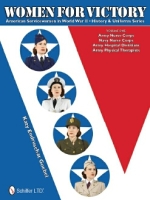 |
|
Supplement: Army Nurse Corps Field
Clothing
Herringbone
Twill Special Uniform: Nurse’s One-Piece Working Suit (p.121.).
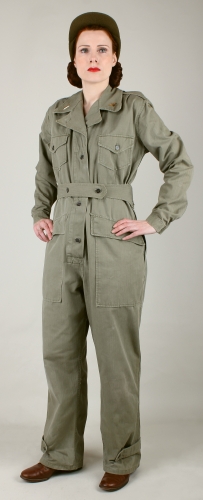 |
.. |
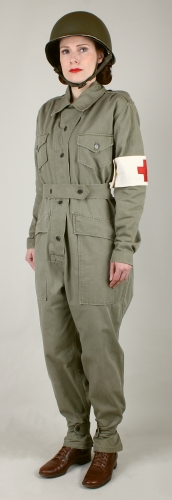
|
|
The
army nurse’s one-piece HBT special working suit was designed as a utility
garment of sufficient durability (i.e., herringbone twill, abbreviated HBT) for
working in tented and open-air medical conditions beyond hospital buildings. It
is worn here in typical field style complete with wool knit cap and women’s
field shoes. |
|
The nurse’s
working suit as worn for forward field duty within a war zone, complete with M-1
steel helmet and Geneva Convention (Red Cross) brassard. The garment's collar is
closed high at the neck and the trousers’ tab-and-button closure is tightly
ankle-adjusted to ward off insects and other field hazards. |
.
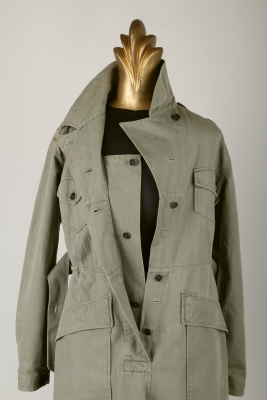
Overall view of the upper portion of the
one-piece working suit with the front displayed open to reveal its protective
fly-piece, which was buttoned inside in conjunction with outer garment buttons
("double-buttoned") to form a gas seal against chemical agent penetration.
|
....... |
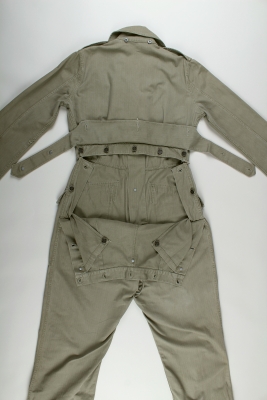
Overall view of the working suit’s mid-back portion with its belt uplifted
to completely reveal the closed drop seat, which fastened by a series of metal
buttons positioned to secure its end in a top-closed position as well as along
both sides. |
.
.
Protective Clothing (p.140)
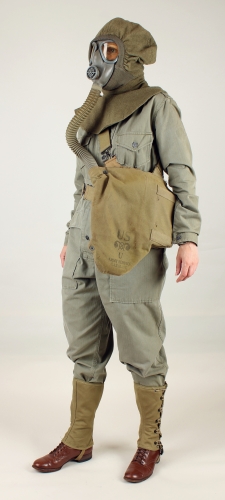 |
.. |
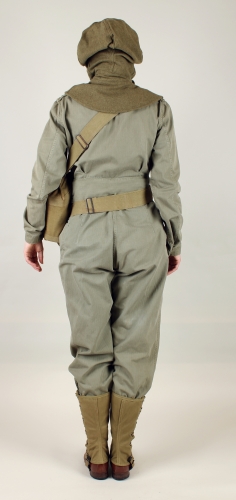
|
|
The nurse’s working suit worn in a typical
chemical-warfare mode configuration with the M2A2 gas mask and M1VA1 carrier
bag; protective wool hood; leggings, and field shoes. For optimum body
protection against toxic agents, this clothing required chemical treatment
("impregnation") along with special protective gloves and underwear.
|
|
Back view of the nurse’s working suit worn
in typical chemical-warfare mode shows how the wool hood covered much of the
shoulder and complete neck area, and also the arrangement of gas mask carrier
bag straps around waist and back to rest the bag securely upon the wearer’s left
side.
|
.
..
Non-Regulation Outfits
Culottes (p.141-142)
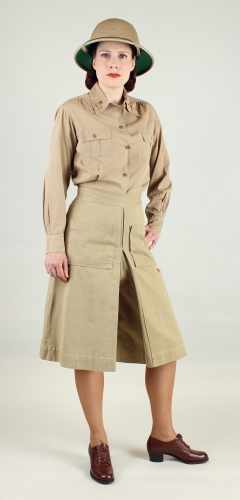
|
.. |
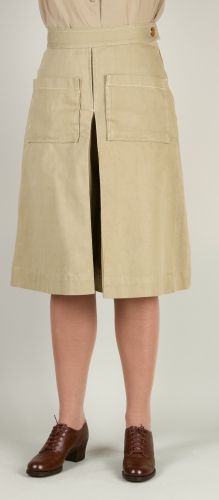 |
|
Khaki cotton culottes
(a.k.a. bifurcated skirt) were obtained by many army nurses stationed in the
Pacific and other tropical zones for working practicality. These
locally-authorized non-regulation culottes are exhibited as typically worn in a
field overseas garrison style complemented by khaki shirtwaist, military pith
helmet and women’s low service shoes.
|
|
Front view of the non-regulation culottes
shows the two large bellow-type patch pockets adapted for nurse working
purposes, which allowed holding medical instruments, bandages and the like. The
culottes were favored because they combined the practicality of pants with the
looks of a skirt.
|
.
.
Safari-Type Jacket
(p.141-143)
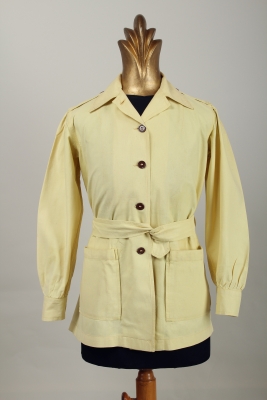 |
.. |
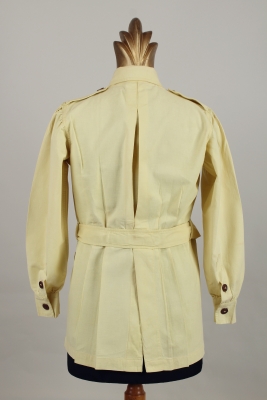 |
|
Front view of an army nurse’s non-regulation
Australian-made olive yellow safari-style jacket. Army nurses in the Pacific
Theater of Operations and adjoining tropical zones were locally authorized to
wear such safari-style jackets (often made in Australia but also elsewhere) at a
number of field overseas garrisons.
|
|
Back view of the example non-regulation
safari-style jacket showing its inverted box pleat in the center and the vent
allowing greater freedom of movement. The self-material belt is partially sewn
onto the middle back of the garment and additionally held in place by side
loops.
|
.
..
Flight Nurse’s Uniform
Type F-1 and A-1 Nurse’s Flight Uniform (p.152-157)
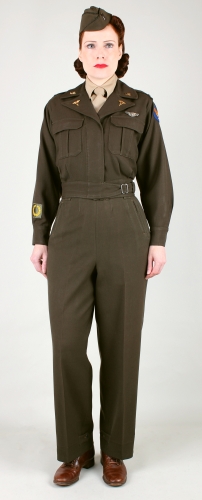 |
.. |
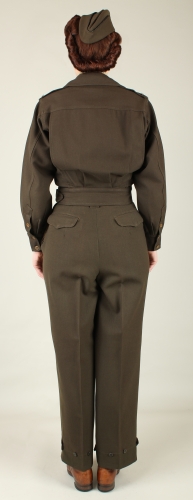
|
|
The Army Air Forces nurse’s flight uniform with
type F-1 flying jacket and type A-1 aviation slacks, khaki shirtwaist, khaki
necktie, women’s officer’s wool garrison cap and field shoes. This dark-olive
drab wool version (instead of earlier gray-blue serge wool) was owned by
Margaret Nadeau assigned to the 831st Medical Air Evacuation Squadron (MAES) in
the Pacific Theater of Operations.
|
|
This back view of the type F-1 flying jacket
and type A-1 aviation slacks shows the jacket design with rear blousing
allowance for extra roominess in bending and stretching, and trim waist-level
appearance. The slacks have two back hip pockets and lower-leg button
positioning for their adjustable tab-and-button closures.
|
.
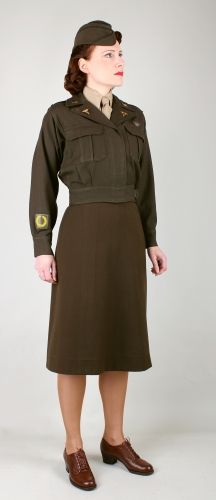
|
.. |
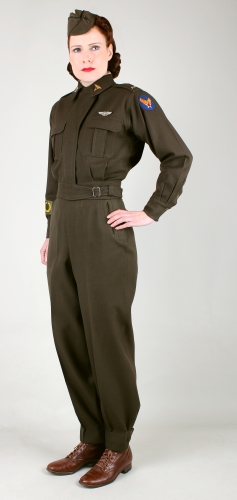 |
|
The olive drab nurse’s flight uniform with type
F-1 flying jacket being worn with the matching type A-1 aviation skirt. It is
accessorized with the women’s officer’s wool garrison cap, khaki shirt, khaki
necktie, beige stockings and women’s low service shoes.
|
|
The type F-1 jacket being worn buttoned high
at the neckline and the type A-1 slacks' lower leg tab closures adjusted tightly
around the ankles. This duty style permitted close fitting of the entire uniform
to insure optimal military performance and appearance despite aircraft fuselage
wind drafts and cold air.
|
.
|
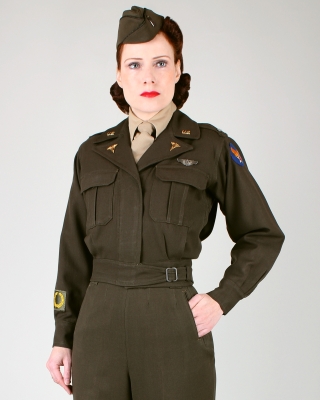
|
....... |
Detail view of the type F-1 flying jacket shows its fly front without visible
buttoning, upper pockets and waistband with metal buckle. Note the Meritorious
Unit Commendation (MUC) sewn onto the lower right sleeve, signifying the nurse’s
unit’s exceptionally meritorious conduct between January 1, 1944 and September
15, 1946.
|
.
|
Detail view of the
official label sewn inside the type F-1 flying jacket shows the garment
designation; special number; size; stock number; order number, manufacturer and
official service property notice. The tag also contains the subsequently added
nurse’s identification markings.
|
....... |
.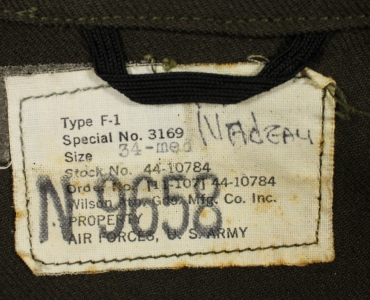
|
.
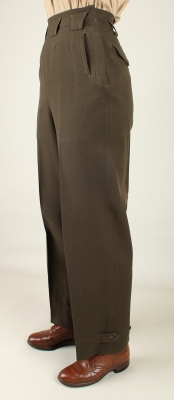
|
.. |
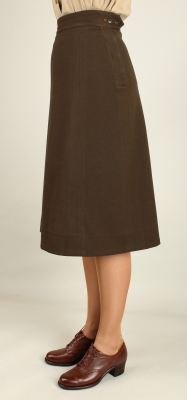 |
|
The olive-drab type A-1 aviation slacks had a
waistband containing wide belt loops, two front slit pockets and two hip pockets
with flaps. The leg ends were furnished with adjustable button tabs.
|
|
The olive-drab type A-1 aviation skirt worn
by army flight nurses had an A-line design with six gores (skirt sections) and a
narrow waistband. It fastened with a covered button closure.
|
.
|
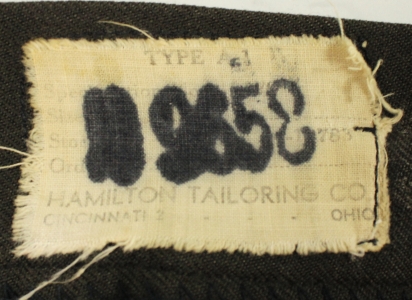
|
.... |
Detail view of the official label sewn on
the inside waistband of the olive-drab type A-1 aviation slacks containing the
garment’s designation; specification number; size; stock number, order number
and manufacturer. The data is partially obscured by personal identification
markings printed across the label.
|
.
|
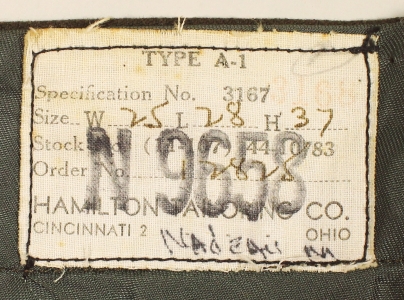
|
....... |
Detail view of the
official label sewn on the inside waistband of the olive-drab type A-1 aviation
skirt containing the garment’s designation; specification number; size; stock
number, order number and manufacturer. The size is given in inches (W for waist,
L for length, and H for hip).
|
.
..
Type L-1 Nurse’s Light Flying Uniform (p.158-160)
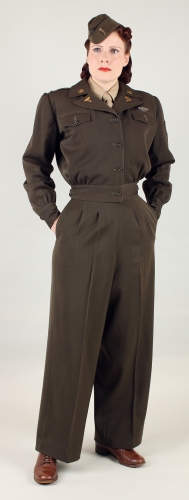
|
.. |
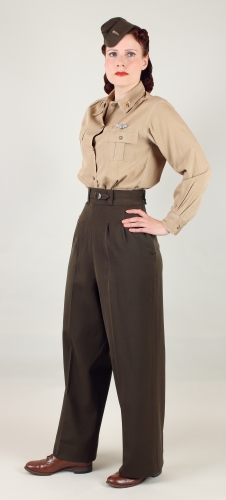 |
|
The type L-1 nurses light flying uniform was made of olive-drab worsted wool
gabardine material and similar in design to the type K-1 nurses very light
flying uniform. It is accessorized with khaki shirtwaist, khaki necktie, women’s
field shoes and women’s officer’s wool garrison cap (instead of type L-1 cap).
|
|
The
type L-1 nurses light flying uniform being worn without type L-1 nurses light
flying jacket, for working comfort indoors with shirtwaist collar open. The
shirtwaist has rank and caduceus insignia of the Army Nurse Corps pinned to the
collar, and the flight nurse badge attached above its left pocket.
|
.
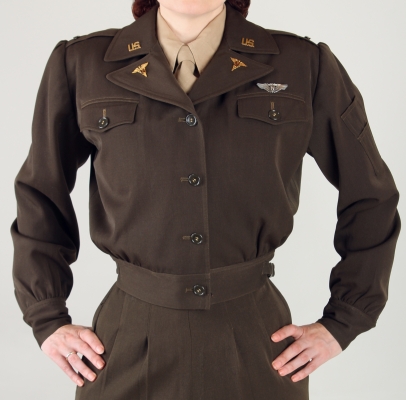
|
.. |
Officially designated as jacket, nurses flying, light, type L-1, this
waist-length jacket had a front button closure, shoulder loops, two front flap
pockets and a pencil pocket on the left sleeve.
|
.
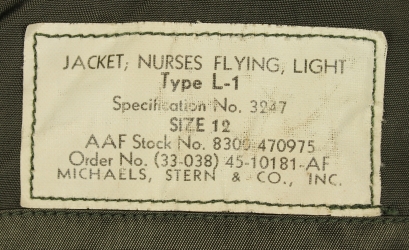 |
.. |
Official label on the type L-1 nurses light flying jacket sewn below the
jacket's back lining panel provided data on the garment designation,
specification number, size, Army Air Forces stock number, order number and
manufacturer.
|
.
|
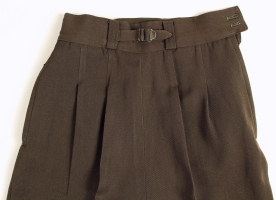
Officially designated as slacks, nurses flying, light, type L-1,
these pants had a broad narrow waistband with belt loops and an adjustable waist
strap at the front, a slit pocket on each side and wide leg design.
|
.. |
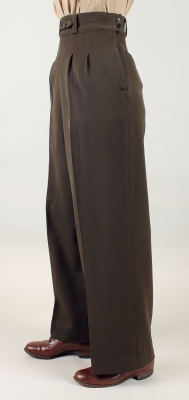
|
.
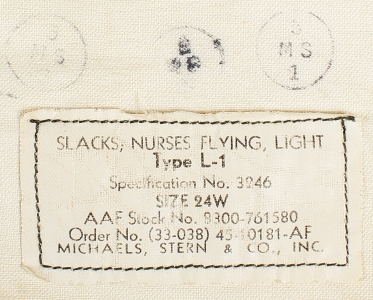 |
.. |
Official label of the type L-1 nurses light flying slacks sewn onto the
backside of the left inside pocket, which contained the garment designation,
specification number, size, Army Air Forces stock number, order number and
manufacturer.
|
.
..
Individual Equipment and Items
Canvas Washbasin (p.207).
|
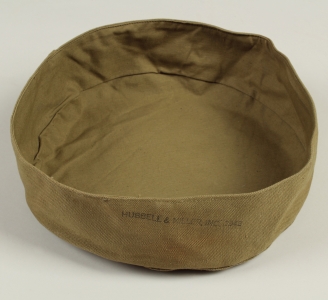
|
.. |
Army nurses deployed overseas were authorized the issuance of a
washbasin made of canvas fabric for washing and general hygiene, while in the
field. It could be folded flat for easy storage, such as within the individual
bedding roll.
|
.
.
War Department Officer’s Identification Card (p.214)
|
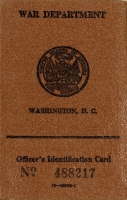
|
........... |
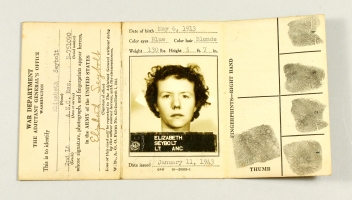
|
War Department officer’s identification card (WDAGO No.65-1) of an
army nurse. The card contains personal identifying
information about the officer, individual photograph in uniform and
fingerprints.
.
Identification Bracelet (p.215)
|
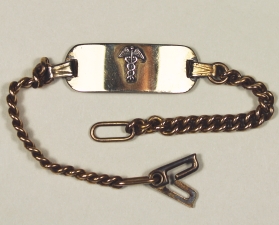
|
.. |
e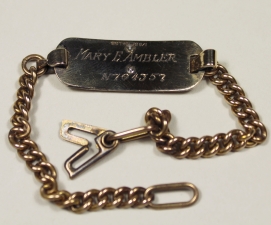
|
Army
nurses were permitted to wear privately-purchased identification bracelets
while in uniform. This example gold-colored bracelet has the caduceus
medical symbol on the obverse side and the nurse’s name and army serial
number inscribed on reverse sid
.
Tentative Packing Directions for Army Nurses (p.215-217)
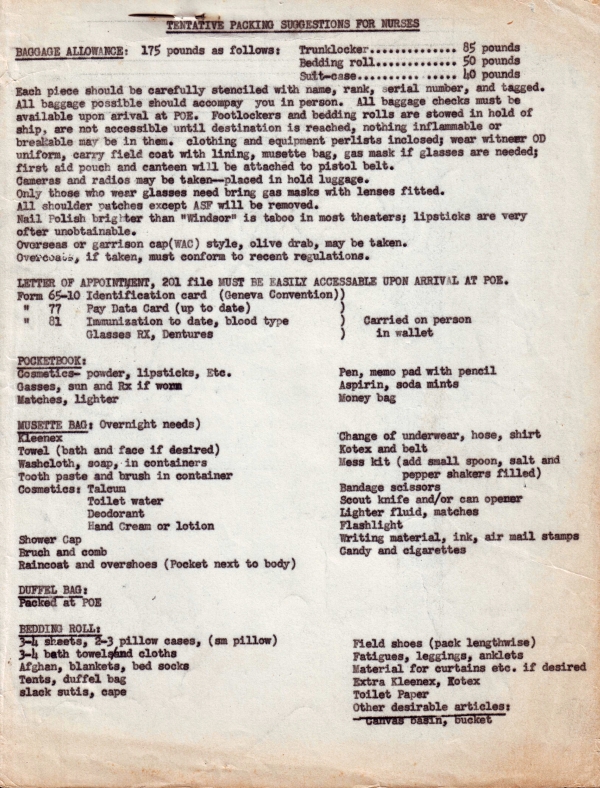
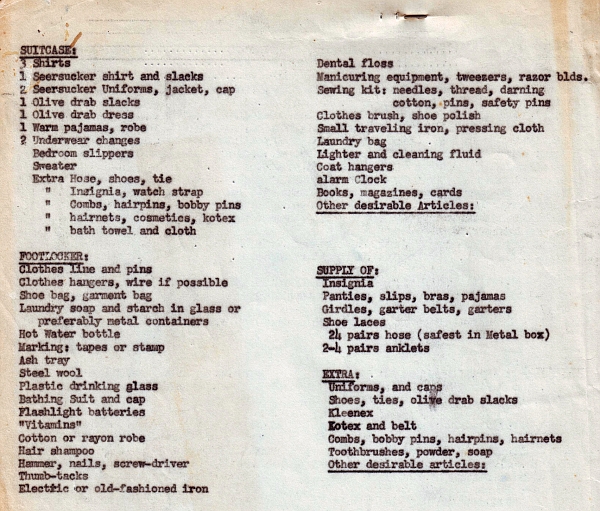
Individual baggage directions for tentative packing of gear and
individual belongings was issued to army nurses deployable for overseas service.
The form listed the military and personal items permitted for baggage purposes,
and detailed storage of articles within each designated bag.
..
Special: Army Nurse Related Articles for Girls
World War II Juvenile Books about Army Nurses (p.220)
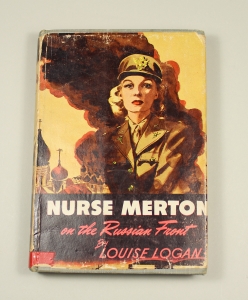 |
.. |
Novelist Louise Logan’s series about army nurse Susan Merton was among many
patriotic service books published for juvenile readers during World War II.
Logan wrote adventure stories of a young woman whose global dual role as nurse
and spy for the United States Army included duty in Russia, depicted here.
|
.
Supplement: Navy Nurse Corps
Flight Nurse’s Uniform
Gray
Flight Nurse’s Summer Working Uniform (p.286).
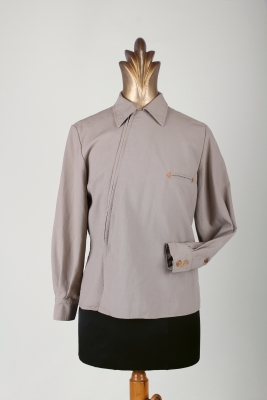 |
.. |
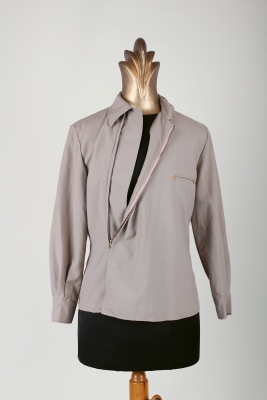 |
|
Front view of the navy flight nurse’s gray cotton shirt with its uniquely
distinguishing diagonal slide fastener (zipper) and upper left pocket reinforced
by triangular stitching.
|
|
The navy flight nurse’s gray cotton shirt is displayed partially open to
reveal the inside finishing of the uniquely designed slide fastener in front.
|
.
Supplement: Army
Hospital Dietitians and Physical Therapists
Individual Items
M-1936 Pistol or Revolver Belt
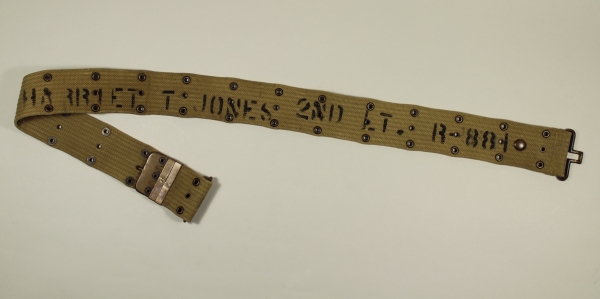
This M-1936 pistol or revolver belt, capable of carrying individual
equipment, was stamped with the personal identification markings of an army
hospital dietitian including her name (first name, middle initial, surname),
rank (2nd Lt) and her abbreviated army serial number (prefix “R” followed by the
last three serial number digits).
.
Individual Identification Tags (p.341)
|
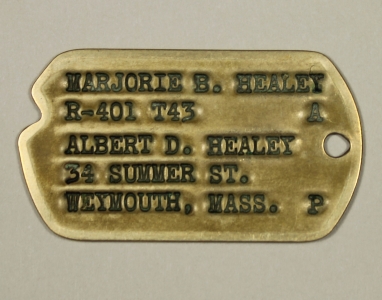
|
....... |
This early-war type identification tag of an army hospital dietitian
is made of brass metal and bears the dietitian’s name, her abbreviated army
serial number (prefix “R” and the last three number digits), date of tetanus
inoculation (T43) and blood type (A); next-of-kin, address and religion (here
“P” for Protestant).
|
.
|
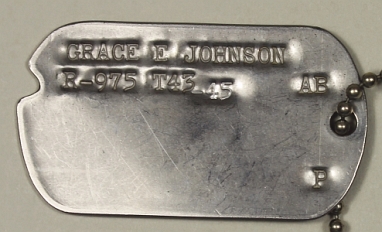
|
....... |
Example set of stainless-steel
identification tags for an army hospital dietitian contains the name order
sequence of first name, middle initial and surname in the style issued between
July 1943 and March 1944. The 1945-dated diphtheria toxoid combination was a
later addition placed after the date of tetanus inoculation.
|
.
|
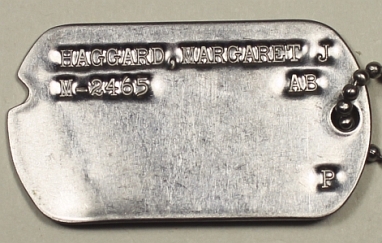
|
....... |
Stainless-steel identification tags for an army physical therapist in the style
issued between March 1944 and April 1946. Note the army serial number starting
with the prefix “M” followed by the last four number digits and the absence of
any tetanus inoculation date.
|
.
Copyright © 2016 by
Katy Endruschat Goebel.
All
rights reserved
|









































